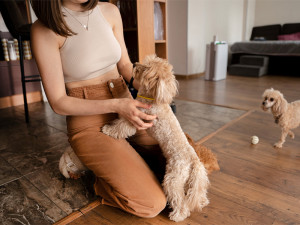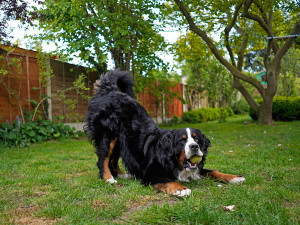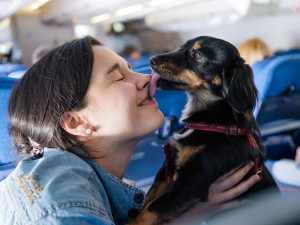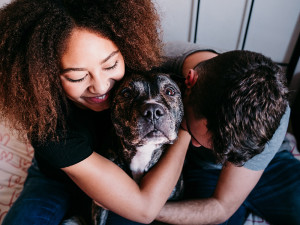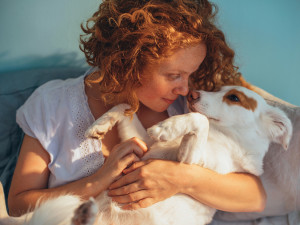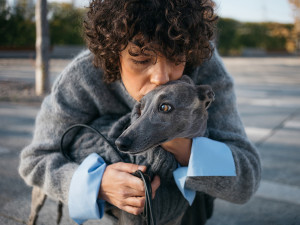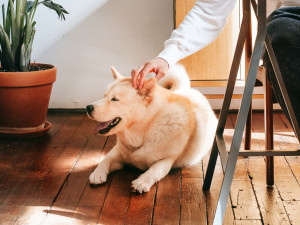Your Dog Can Understand Your Facial Expressions, Study Says
And they love it when you smile.

Share Article
On a good day, you come home smiling, maybe even singing that Chappell Roan song you’ve had stuck in your head for months. You’re happy. Your dog comes running up to you, tail wagging, taking on your cheerful mood.
Or you come home from the worst day at work and instantly flop onto the couch to have a cathartic cry. As your face scrunches up and tears start to flow, you feel something gently tap one of your heaving shoulders. It’s your dog, just placing a paw on you, as if to say, I’m here. It’s OK.
Dogs have an uncanny ability to connect with humans, often seeming to read our emotions easily. But do they really know what is going on in your head? Here’s what researchers found about their ability to discern different facial cues, how they respond, and what you can do as a dog parent to improve communication with your pup.
Can dogs understand facial expressions?
The short answer is: yes. Dogs pay attention to human facial expressions. A 2021 study found opens in new tab that dogs can distinguish between happy and angry human faces. They use their memories of real emotional human faces to identify both feelings. Pups prefer smiling faces to sad ones, suggesting they might understand who might be a friendly presence in their lives.

Veterinarian Dr. Kathryn Dench, the chief scientific advisor at Paw Originsopens in new tab, tells us she has observed a significant percentage of her pup patients consistently show a sensitivity to their parents’ emotional states, which are often reflected in how they respond to care routines and cues.
“Every day in the clinic, I see evidence of this empathetic connection. Dogs recognize happiness or sadness and respond in ways that seem emotionally supportive, such as cuddling closer when an owner is visibly upset,” Dench says.
How do dogs tune into our feelings so well?
Dogs are essentially empaths, but how do we know this? This ability may depend on the extensive human-dog interactions and domestication.
Philip Tedeschi, human-animal connection expert with Rover and founder of the Institute for Human-Animal Connectionopens in new tab at the University of Denver, believes that the intimate evolutionary relationships between dogs and humans have led dogs to be more emotionally attuned to their parents. “The co-evolution between people and animals, a feature of domestication, has led dogs to exhibit a consistent ability to detect, distinguish and respond to their human counterparts,” Tedeschi says.
He adds that human-dog interactions have allowed pups to become sensitive to nuances in human behavior and emotion, and are thought to be some of the most intelligent social animals when it comes to understanding people.
“People frequently report that their dogs are more quickly and sensitively discerning of their human's emotional experience,” he says. “It looks like facial expressions and other interpersonal information inform dogs of acute emotional shifts in those around them.”
Plus, dogs are very observant creatures. Even when asleep, minor noises, and position shifts will get them curious. Tedeschi adds: “The careful observation by dogs specifically focuses attention to facial expression, body gestures, and relevant olfactory data, which translates to responsive social-emotional awareness.”
Dogs respond using their own facial and body cues.
You know a dog can understand your facial expressions by the way they respond to you. One 2017 study showed that dogs reacted differentlyopens in new tab when shown happy and angry human facial cues. Dogs licked their mouths when they saw photos of angry human faces, but not when they heard furious voices. The mouth-licking behavior is an appeasement body signalopens in new tab during dog-to-dog conversations. A dog exhibits this to let their fellow pups know they’ve come in peace.
Researchers at Portsmouth University’s Dog Cognition Centre found that pups created more facial expressionsopens in new tab when their parents are attentive than when they are not. Some cues include blinking, nose licking, tail wagging, and whining.
Dogs mainly use body language to communicate with humans. For instance, tail-wagging is often associated with happinessopens in new tab, but it’s not always the case. Observe the tail’s position and the wag’s direction and speed to determine their emotions and intentions.
The faster the wag, the happier the dog. This type of wag usually happens when your pup’s tail wags with their whole body. Your dog usually does this when you get home after spending time away. On the other hand, a faster, twitch-like wagging tail might indicate negative arousal.
Raised hackles, or the hairs along your dog’s back, are a sign of arousal. It could mean they’re stressed but could also be excited about something. It’s an involuntary act that can happen anytime.
Their posture is also a strong indicator of their mood. A cowering dog is scared or stressed. A pup exposing their belly could indicate they’re either relaxed or anxious. They may even pee a bit in appeasement. You might notice them placing their chest close to the ground with their bottoms in the air, aka the play bow. The play bow is used when they want to play with their parents or other dogs.
A dog’s eyes say a lot. Soft eyes have relaxed lids, so it can seem like your pup is squinting. This eye language indicates calmness or happiness. On the other hand, when your dog’s eyes appear cold, it means they’re defending something, such as food or a toy. Eye contact is essential for dogs — a hard stare may signal aggressionopens in new tab, and looking awayopens in new tab can mean they are stressed or anxious and trying to calm down.
They can communicate through their eyes. If you leave home for work every day, you may notice your dog’s eyes well up as you arrive. Believe it or not, these are tears of happiness — they’re glad they’ve finally reunited with you. A 2022 study suggestsopens in new tab that oxytocin triggers tear production, which increases when dogs are reunited with their parent.
You can improve communication with your dog.
Now that you know dogs can read your facial expressions, you must remain mindful of your actions when interacting with your pup. Dench advises pet parents to be more conscious of their emotional state and expressions when interacting with pets, especially in stressful, training, and bonding situations.
She says: “Maintaining a calm, happy demeanor can help soothe a pet during visits to the vet or in new environments. Additionally, showing positive facial feedback when a dog obeys a command or behaves well can reinforce good behavior more effectively than words alone.”
Consequently, Tedeschi thinks it’s helpful to remember that dogs — powered by their deep commitment to knowing their human parents — are capable of complex thinking. “We should reciprocate and also be observant of them, their individual and species-specific needs, opinions, capacity for consent and desires,” he adds. “For instance, I always try to acknowledge my dogs by name when they enter the room.”
Dogs are highly emotional animals — your dog can sense your facial cues and feelings because they’re always paying attention to you. Remember to always respond positively to them. For instance, if your pup is scared and runs away after seeing an object, it’s best to remove or walk away from that trigger instead of pulling them closer. You can also sit with them until they are less scared.
Remember how your mood can affect your dog. For instance, if you feel angry at the time you plan to take your four-legged friend for a walk, you may want to take a beat to calm down before you head out. Your pup might even associate your walk with negative emotions when you get more frustrated.
While negative emotions — such as anger and sadness — are inevitable, try not to channel them toward your pup. They’re your best friend — if anyone is going to make you smile again, it’s them.
Stay positive.
Dogs can respond to your facial cues — from mouth-licking to tail-wagging — without saying a word. Their ability to discern human facial expressions is a testament to the deep bond between humans and dogs. While there’s still much to learn, the conclusion is clear — your buddy is far more emotional and perceptive than you often give them credit for. Thank them by providing them with the care and love they deserve.
References:
Mouth-Licking by Dogs as a Response to Emotional Stimuliopens in new tab
Increase of Tear Volume in Dogs After Reunion With Owners Is Mediated By Oxytocinopens in new tab

Jack Shaw
Jack Shaw is a passionate writer with a focus on promoting health and wellbeing in both pets and their parents. With a deep love for animals, he strives to bridge the gap between human wellness and animal care. His articles aim to inspire readers and their pets to lead healthier lives while fostering a compassionate connection with the world around them.
Related articles
Why Does My Dog Lick Me? The Meaning Behind Dogs Licking Us
The sentiment is nice, but...
![Couple hugs their merle Boxer]()
How to Improve Your Relationship with Your Dog
Animal behaviorist Dr. Karen B. London on how to strengthen your pet-parent bond.
![A woman holding her dog close.]()
FYI, Your Dog Can’t Stand When You Do These 7 Things
Thanks, they hate it.
Do Dogs Love Their Human Parents?
You can certainly feel the love.
How to Tell If Your Dog Is a Hugger—Or Not
Boundaries, folks. Boundaries.
![Unrecognizable man sitting at desk petting his dog]()
How to Pet a Dog — Yes, You Do Need Lessons
There’s a difference between being affectionate and being annoying.
